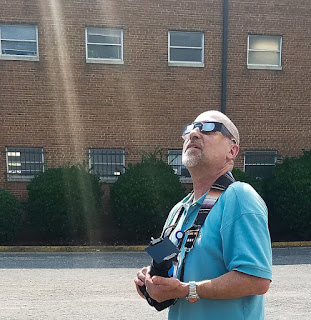Finally! The playing field is level between professional photographer and enthusiast or hobbyist.
It is so easy to create professional quality work, and even have your work published, that the label of "amateur" hardly applies in the world of photography.FILM:
If you are old enough to remember when you only had 35mm film, you'll recall feeling like you could not complete with the pros. They shot a thousand pictures at a time, and you were limited to maybe two or three rolls of film (36 exposures each) which had to last a month (and you dreaded the developing costs).Digital has changed all that.
EQUIPMENT:
You had one camera, maybe a Mamiya, Minolta, or a Miranda, and two lenses (the 50mm lens which came with the camera and an off-brand 135mm tele). This meant you were stuck with one type of film (and thus limited in photography subjects) until you finished the roll. The pros had three or four cameras on every shoot, Nikons of course, with different ISO films and lenses attached.Digital has changed all that.
THE RESULTS:
The pros had superior photos, certainly because of their talent, but also because they were paid to practice. They got the assignments which paid them while they developed their skills. Their learning curve was fast and steep. For the rest of us, it took years to learn the craft.Digital has changed all that.
So I say, game on!
WHAT TO DO:
Let's buy some high quality lenses and great versatile camera bodies. We'll get high quality zoom lenses, auto-focus, auto-exposure, and motor drives (which in the past was another luxury only the pros had). Best of all, we get all the FREE shooting and processing for as many photos as we can take.That is way better than what even the professionals used to have in the past.
MY RECOMMENDATIONS:
Camera. You can get a complete DSLR camera set up with two zoom lenses for what you might spend on dining out over the course of a year. These are wonderful times for us, the students and adult learners. Also, you can shop on line, so we don't have to make a trip to the big city to get a good deal. You can even find great deals on camera equipment at Costco or Best Buy. For Processing. I recommend Lightroom. It is a very versatile program supported by Adobe with free tutorials. Also, there are many free videos on YouTube, and many good classes for a fee you can take as well.MY AFFILIATE LINKS (you pay the same, but I get a commission):
Adorama
Amazon
SHOPPING LIST:
·
Camera (Kit with 2 lenses)
·
Camera bag
·
Camera Batteries and Charger
·
Camera body (an extra one)
·
Camera Strap
·
External drive storage
·
Filters and Filter kits
·
Lenses (a couple of extras)
·
SD Cards
·
Tripod
DETAILS:
For the really important (and expensive) items like additional lenses or when you want to upgrade your camera body, Adorama is reliable, they provide safe shipping, and have an excellent return program. They usually have the lowest price on an authentic Nikon camera battery.If you are buying an off-the-shelf kit, meaning a camera with two lenses included (like an 18 - 55mm zoom and a 55 - 200mm tele), plus charger and accessories, you can find a good package deal at Costco.
Best Buy has a good deal on quality camera tripods, a good selection of camera bags, sometimes on SD cards or camera batteries too. ALWAYS buy the name brand camera battery for your camera. I only buy Nikon batteries now because I bought two of the off-brand batteries and they simply do not last as long.
Staples is an office supply place that has good deals on SD cards and Terrabyte drives, especially around Thanksgiving (sometimes before, sometimes during, and sometimes after). When you are in the market for an additional drive, watch the Staples sales flyer every week for the sale price. I buy Seagate drives because they are small and so far, super reliable.
Get a cool camera strap on Amazon, and ditch the Canon or Nikon strap. You are just asking for someone to grab your camera when you use the logo to brag. If you are taking photos in a sketch area, or developing country, then get a security type strap with can't be cut with a blade. Pacsafe has different styles.
See my separate blog post on filters, which ones to buy, and how to use them.
If you are getting extra lenses, I would recommend a standard 35mm or 50mm f1.8 lens. This is usually very inexpensive, and you will need it in low light situations. The kit zoom lenses which come with the camera do not have a wide an opening, The next extra lens to get is a super wide angle, or wide angle zoom. Get something that goes to 8mm so you can take some really crazy shots of cars and statues, and the insides of small rooms. You can by an off brand, rather than your camera's brand to save money. You will only need this lens once in a while, so don't spend more than you have to.
Here are a couple of my wide-angle shots with my Sigma 8-16mm, which I bought at Adorama:
Buoys in Maine
Fall foliage in the forest





























